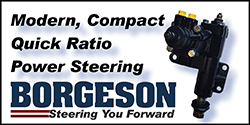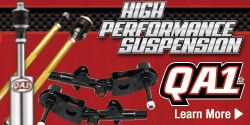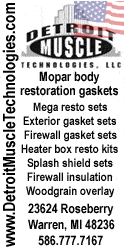from what i gather i need to remove carb and ensure t slots are correct gap(35-45 thou) with idle speed screw,
That will be helpful, but there is no 'correct'. As that's my post you reference, the goal is to have the t-slot exposure in the operating range. On a Holley 4150/60 and similar that is usually .0.20 to .040" exposed.
With the carb off, observing the amount exposed for each 1/4 turn of the adjustment screw provides a future reference in your notebook.
However, it sounds like you have an Edlebrock based on Carter's AFB or AVS. The principle is similar but I don't have a numerical range to offer. Additionally, Carter used a slightly different idle circuit design. One could say its a little more sophisticated.
reinstal, turn dist advancing until i reach the point where idle stops increasing?
No. In part for the reason you ask next and because there is nothing gained by increasing idle speed (unless that's what's needed to keep it running).
so what happens if its too fast OF IDLE THEN? if i cannot reduce idle with idle screw as that will change t slot gap? or do i just adjust dist until i have 800 rpm or so and thats my initial?
If anything, your goal is the strongest idle at the lowest rpm.
Getting it running and warmed up. Then see if you can set the timing close to the initial you think is appropriate for the engine. Check the rpm. Then you have a decision to make depending on the rpm. If the rpm is too high or too low. Either adjust the throttle position slightly, or adjust the initial timing.
Since the engine is idling OK at a 750-800 its in the ballpark. Now you could try adjusting the idle mix screws. If turning them in doesn't cause the engine to stumble, then there is too much transfer slot exposed. Based on what you wrote, I suspect thats not going to be a problem.
If turning them in does cause the engine to start to die, turn them back 1/8 turn at a time until the engine cleans up, then another 1/8 turn richer. Now go check rpm and timing again. Next is decision time. Are you satisfied? I wouldn't be, but everyone is different. If it was me I'd try either a small change in throttle
or a small change in initial timing. Then readjust the mix screws and recheck the rpm and timing.
The 100 rpm difference between Park and Drive is OK for modified engine, but you may be able to get it a little better. Try a little more timing and then a little less timing, and a little richer.
With most any distributor expect to find timing changing with any time the engine is over 750 rpm.
In another words, if the timing at 18* and the rpm is 800, then 18* is may not really be initial timing. When the engine is slowed to 650 rpm, then the timing may be 14*. If at 650 and 700 rpm the timing is the same, then that's the real initial, or darn close to it. Keep track of all the timing and rpms, along with any changes you make.
Vacuum at idle is 13-14", max vacuum is 19-20" driving.
It seems to suggest a 'moderate' cam. My guess is maybe something with duration around 220 at .050.
Read this entire thread, more confused as ever as i dont know cam/build etc.
LOL
This is NOT the thread to reference for working out your engine's need. At best its a discussion about factors that impact spark lead.
My advice is start a new thread. Jumping in here is liking jumping into a cow paddy throwing contest.



















